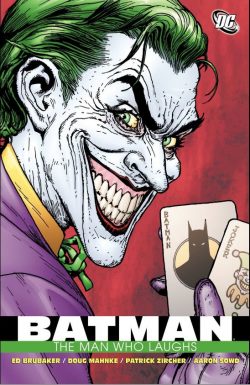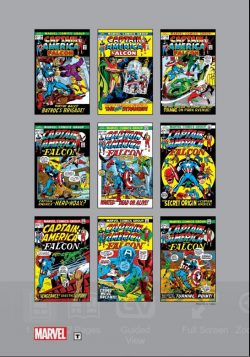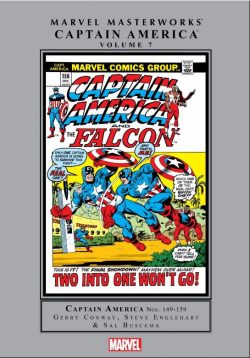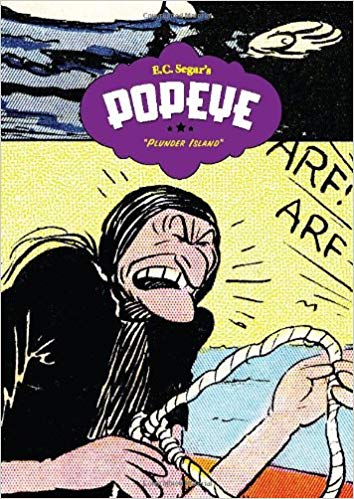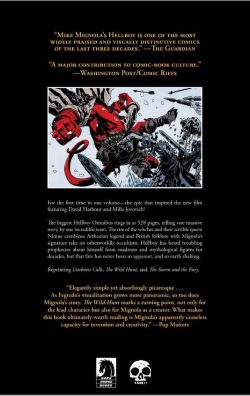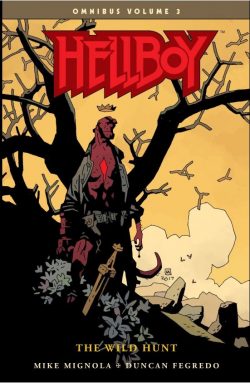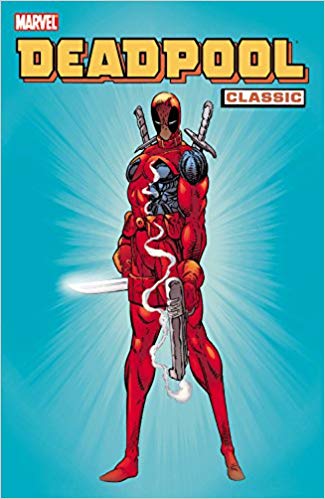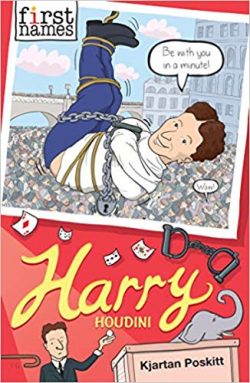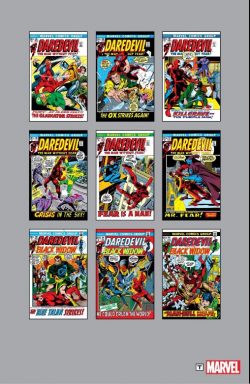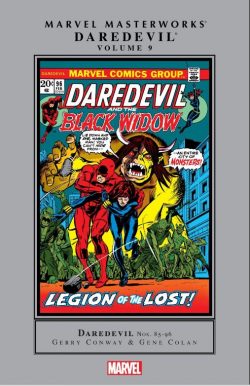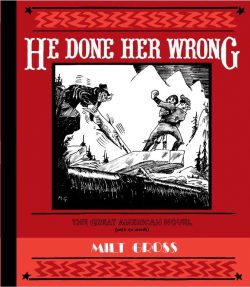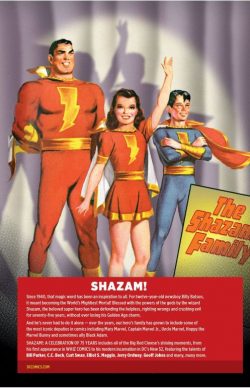
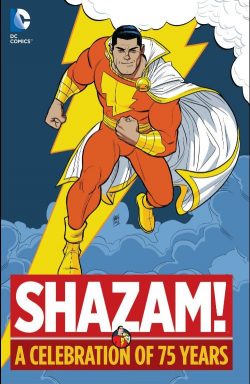
By Bill Parker, Otto Binder, Elliot S. Maggin, Denny O’Neil, E. Nelson Bridwell, Roy Thomas, Paul Kupperberg, Alan Grant, Jerry Ordway, Joe Kelly, David Goyer, Geoff Johns, Jeff Smith, C.C. Beck, Marc Swayze, Mac Raboy, Pete Costanza, Chad Grothkopf, Curt Swan, Kurt Schaffenberger, Don Newton, Rich Buckler, Barry Kitson, Peter Krause, Duncan Rouleau, Leonard Kirk, Gary Frank & various (DC Comics)
ISBN: 978-1-4012-5538-1 (HB)
At their most impressive, superhero comics combine the gravitas of mythology with all the sheer child-like fun and exuberance of a first rollercoaster ride. A perfect example of this is the original happy-go-lucky hero we can’t call Captain Marvel anymore.
First seen in the February 1940 issue of Whiz Comics (#2 – there was no #1) and cashing in on the comicbook sales phenomenon of Superman, the big red riot eventually won his name after narrowly missing being Captain Flash and Captain Thunder. He was the brainchild of Bill Parker and Charles Clarence Beck. Originally dispensing the same sort of summary rough justice as his contemporaries, the character soon distanced himself from the pack – Man of Steel included – by an increasingly light, surreal and comedic touch, which made him the best-selling comics character in America.
Billy’s alter ego could beat everybody but copyright lawyers; during his years of enforced inactivity the trademarked name passed to a number of other publishers before settling at Marvel Comics and they are never, never, never letting go. You can check out and compare their cinematic blockbuster version with the DC Extended Universe’s Shazam! flick too…
Publishing house Fawcett had first gained prominence through an immensely well-received magazine for WWI veterans entitled Captain Billy’s Whiz-Bang, before branching out into books and general interest magazines. Their most successful publication – at least until the Good Captain hit his stride – was the ubiquitous boy’s building bible Mechanix Illustrated and, as the comicbook decade unfolded, the scientific and engineering discipline and “can-do†demeanour underpinning MI suffused and informed both the art and plots of the Marvel Family titles.
As previously stated, the big guy was created by writer/editor Bill Parker and brilliant young artist Charles Clarence Beck who, with his assistant Pete Costanza, handled most of the art on the series throughout its stellar run. Other writers included William Woolfolk, Rod Reed, Ed “France†Herron, Joe Simon, Joe Millard, Manley Wade Wellman and the wonderfully prolific Otto Binder.
Before eventually evolving his own affable personality, the Captain was a serious, bluff and rather characterless powerhouse whilst his junior alter ego was the true star: a Horatio Alger archetype of impoverished, boldly self-reliant and resourceful youth overcoming impossible odds through gumption, grit and sheer determination…
Collecting in a big bold hardback trade paperback (and assorted digital formats) Whiz Comics #2, 21, Captain Marvel Adventures #18, 38, 39, 137, 148, Captain Marvel Jr. #12, Marvel Family #1, Hoppy the Marvel Bunny #6, Shazam! #1, 29, Superman #176, World’s Finest Comics #275, DC Comics Presents #49, L.E.G.I.O.N. ’91 #31, The Power of Shazam! #1, 2, 33, Action Comics #768, JSA #48, Shazam!: The Monster Society of Evil #2, Justice League #21 and The Multiversity: Thunderworld #1 this is a magnificent primer of key moments and triumphs for a hero to whom change is everything…
The action opens in the Golden Age as Part I 1940-1953: The Big Red Cheese offers an abridged version of writer and historian Richard A. Lupoff’s 1992 Introduction to the Shazam Archives volume #1: a context-setting appreciation and appraisal covering the facts of his creation and his impact, after which Whiz Comics #2, (February 1940) provides our glimpse of the boy hero…
Drawn in a style reminiscent of early Hergé, ‘Introducing Captain Marvel’ sees homeless orphan Billy Batson lured into an abandoned subway tunnel to a meeting with millennia-old wizard Shazam. At the end of a long, long life fighting evil, the white-bearded figure grants the lad the power of six gods and heroes (Solomon, Hercules, Atlas, Zeus, Achilles and Mercury) and urges him to carry on the good fight. In thirteen delightfully clean and simple pages crafted by Bill Parker & C.C. Beck, Billy gets his powers, has his secret origin revealed (he’s heir to a fortune embezzled by his crooked uncle Ebenezer), wins a job as a roaming radio reporter for Amalgamated Broadcasting on Station WHIZ, and defeats the mad scheme of Doctor Thaddeus Bodog Sivana who is holding the airwaves of America hostage. Defeating the demonic mad scientist sets a pattern that would captivate readers for the next 14 years…
Next, from Whiz Comics #21 ‘The Vengeful Four’ (September 5th 1941 – fortnightly, remember?) is an uncredited script limned by Beck wherein Sivana gathers three other villains to attack the hero in his youthful identity. What luck then that three other kids named Billy Batson are in town and that the magic of Shazam apparently extends to them…
Fat Billy, Tall Billy and Hill Billy took to trouncing thugs in a trice and, as the Three Lieutenant Marvels, would become frequent guest stars in years to come…
Billy soon found a companion in peril when Fascist überman Captain Nazi almost murders newsboy Freddie Freeman. Guilt-plagued Billy brings the dying lad to Shazam’s mystic citadel where the old wizard saves his life by granting him access to the power of the ancient gods and heroes. Physically cured – except for a permanently maimed leg – there is a secondary effect: whenever he utters the phrase “Captain Marvel†Freeman transforms into a super-powered, invulnerable version of his mortal self…
That origin isn’t included here but does lead into the debut of Billy’s long-lost twin sister. Cover-dated December 11th 1942, Captain Marvel Adventures #18 cover features ‘Captain Marvel Introduces Mary Marvel’ (by Otto Binder, Marc Swayze & Mac Raboy) as radio contest competitor Mary Bromfield – a wealthy (adopted) heiress – is kidnapped. While saving her, Billy and Freddie uncover the family connection and Mary discovers that shouting “Shazam!†has a remarkable effect upon her too…
While the adult Captain Marvel was having increasingly light-hearted adventures, Freddie’s adventures in Master Comics and Captain Marvel Jr. were dark and dramatic: illustrated with potent, dynamic verve and grace by one of the most gifted draughtsmen of the era. A typical magnificent example features here as Captain Marvel Jr. #12, (October 1943, by Binder & Mac Raboy) provides the boy hero with a brutal arctic rematch against Captain Nazi in ‘Baffin Land’…
Fawcett in full bloom was a true publishing innovator and marketing dynamo – now regarded as the inventor of many established comicbook sales-tactics, and storytelling innovations we all take for granted today were invented by their creative folk. Fawcett was responsible for creating crossover-events and also devised a truly unforgettable villain as part of a two-year long continued story!
The “Monster Society of Evil†began in March 1943’s Captain Marvel Adventures #22, and blazed away until ending with issue #46 (May 1945). The alien tyrant in charge was a malevolent worm from Venus dubbed Mr. Mind. Included here are two chapters – #17 and 18 from Captain Marvel Adventures #38 & 39 September and October 1944. Crafted by Binder & Beck, ‘Mr. Mind’s Movie Madness’ and ‘Peril Behind the Camera’ pits Billy and his older self against the utterly vile ubi vermis (that’s Latin for worm, science fans) during the making of the world’s worst monster movie…
‘The Mighty Marvels Join Forces’ (December 1945 by Binder, Beck & Pete Costanza) finds Billy, Mary and Freddie battling the depraved and corrupted Black Adam, who was old Shazam’s first gods-empowered champion 5000 years ago in the lead tale from team-title Marvel Family #1 (December 1945).
Superheroes began to fall from popularity as WWII ended and every publisher began searching other genres. Fawcett had already applied their winning formula to the all-ages cartoon critters market with Fawcett’s Funny Animals #1 (December 1942), which featured a lop-eared costumed crusader. Hoppy the Marvel Bunny (by Chad Grothkopf) got his own title as hostilities died down, and from #6 (November1946) comes ‘Phantom of the Forest’ as the mighty rabbit exposes supposed ghosts terrorising woodland folk…
The post-war years were simply magical times, with the creative crew at the top of their game. Captain Marvel Adventures #137 (October 1952) provides ‘King Kull and the Seven Sins’ by Binder, Beck wherein a beast-king from a pre-human civilisation frees the embodiments of Man’s greatest enemies from Shazam’s custody to plague the planet. These are wholesome tales for the entire family, however, so don’t worry – “Lust†has become “Injustice†and “Wrath†is “Hatredâ€, here…
The last yarn is from the Good Captain’s final year of Golden Age publication: a year that generated some of the best tales in the entire run, represented here by the wonderfully surreal ‘Captain Marvel Battles the World’ from Captain Marvel Adventures #148 (September 1952, by Binder and Beck) wherein Earth decides it has had enough of humanity mistreating it and tries to wipe out life and start again…
DC, in their original identity of National Periodical Publications, had filed suit against Fawcett for copyright infringement as soon as Whiz Comics #2 was released, and the companies had slugged it out ever since. In 1953, with sales of superhero comics decimated by changing tastes, Captain Marvel’s publishers decided to capitulate. They settled and the “Big Red Cheese†vanished – like so many other superheroes – becoming no more than a fond memory for older fans…
In Britain, where an English reprint line had run for many years, creator/publisher Mick Anglo had an avid audience and no product, and so swiftly transformed Captain Marvel into the atomic age hero Marvelman, continuing to thrill readers into the early 1960s.
DC eventually acquired all rights, titles and properties to the Captain Marvel characters. Beck returned to commercial and magazine illustration, while Binder & Schaffenberger joined the victorious opposition, becoming key Superman creators of the next few decades….
At the height of his popularity Captain Marvel was an international franchise across the world. However, tastes and the decade changed, and the mighty marvel faded away. Time passed, other companies and heroes were created and also failed, as America lived through another superhero boom-and-bust. We call it the Silver Age now…
The Bronze Age of the 1970s dawned with a shrinking industry and a wide variety of comics genres servicing a base that was increasingly founded on collector/fans and not casual or impulse buys. We rejoin our hero with the new decade fully founded as Part II 1973-1993: Cancellation and Revival sees his glorious return…
National Periodicals – rebranded as DC Comics – needed sales and were prepared to look for them in unusual places. After 1953’s settlement with Fawcett, they had secured the rights to Captain Marvel and Family, and even though the name itself had been taken up by Marvel Comics (via a circuitous and quirky robotic character published by Carl Burgos and M.F. Publications in 1967), DC decided to tap into that discriminating older fanbase.
In 1973, DC turned to the Good Captain to see if his unique charm could work another sales miracle during one of comics’ periodic downturns. Riding a wave of mass-media and movie nostalgia, they revived the entire beloved Captain Marvel cast in their own kinder, weirder universe.
To circumvent the intellectual property clash, they entitled the new comic book Shazam! (‘With One Magic Word…’) the trigger phrase used by the majority of Marvels to transform to and from mortal form and a word that had already entered the American language due to the success of the franchise the first time around.
Recruiting the top talent available, the company tapped editor Julie Schwartz – who had a few notable successes with hero revivals – to steer the project. He teamed top scripter Denny O’Neil with original artist C.C. Beck for the initial story…
All this is succinctly covered in E. Nelson Bridwell’s essay (originally published in 1978’s All-New Collectors Edition #C-58) which leads off this eclectic second section…
Strangely positioned before that debut, however, comes Superman #176 (June 1974): Elliot S. Maggin, Curt Swan & Bob Oksner’s ‘Make Way for Captain Thunder!’ The sales and fan rivalry between fans of the Man of Steel and Big Red Cheese (Sivana’s pet name for his stout-hearted nemesis) had endured for decades, and Schwartz took full advantage by having the two finally – if notionally – meet, courtesy of magical trans-dimensional jiggery-pokery in a titanic tussle to delight 10-year-olds of all ages.
You will recall, I’m sure, that Captain Thunder was one of the options considered in 1940 before Fawcett went with the Marvel name…
Finally, then comes Shazam! #1 (February 1973)… ‘In the Beginning’ recounts, in grand old self-referential style, the classic origin whilst ‘The World’s Wickedest Plan’ relates how the Captain, his super-powered family and all the supporting cast (there’s a very useful seating chart-cum-biography page provided for your perusal) had been trapped in a timeless state for 20 years by the invidious Sivana Family who had subsequently been trapped in their own Suspendium device too.
Two decades later, they are all freed, baddies included, to restart their lives and resume their feuds.
Beck was profoundly unhappy with the quality of stories he was given to draw and soon left the series. One of his assistants and stable-mates from the Fawcett days had been a Superman Family mainstay for decades and smoothly fitted into the vacated lead-artist position. Kurt Schaffenberger was delighted to again be drawing one of his all-time favourite assignments again, and his shining run is represented here by Shazam! #29 (June 1977), as ‘Ibac meets Aunt Minerva’ (Bridwell, Schaffenberger & Vince Colletta. Set in Buffalo, New York and at Niagara Falls, it features a comedic battle of the sexes that was heavy on the hitting. Although the series was not a soaring success, it had spawned a hit kids TV show, introducing the Big Red Cheese to a new generation of viewers…
When the title was cancelled, the Shazam Family began appearing in anthology titles such as World’s Finest Comics with the scent gradually shifting from whimsy to harder-edged contemporary superhero stories. Here WF #275 (January 1982) supplies ‘The Snatching of Billy Batson’ by Bridwell, Don Newton & Dan Adkins; a stirring crime thriller mystery with Freddie taking the lead role…
Team-up title DC Comics Presents #49 (September 1982) then features ‘Superman and Shazam’ (Roy Thomas, Paul Kupperberg, Rich Buckler & John Calnan) which sees the immortal wizard enlist the Action Ace’s assistance to create a Captain Marvel for Earth-1. It does not go well after Black Adam interferes…
Now fully part of the DC universe, Captain Marvel popped up everywhere. He was even a long-suffering straight man in Justice League International for a while, and here (from L.E.G.I.O.N. ’91 #31, September 1991) Alan Grant & Barry Kitson concoct a wickedly funny slugfest as the big red boy scout tries to reason with drunk and hostile super-lout Lobo in ‘Where Dreams End’…
After a number of ill-received reinventions of the Shazam! concept and franchise – revised over and over again to seem relevant to a far darker, more hopeless and uncompromising world and readership – in 1994 a fresh new treatment by Jerry Ordway revitalised the heroic legend; offering a thoroughly modern but spiritually pure reboot that finally held the interest of modern readers.
Following Ordway’s introduction to Part III 1994-2010: The World’s Mightiest Mortal, a too-brief selection of those tales begins with ‘Things Change’ and ‘The Arson Fiend’ (by scripter Ordway, Peter Krause & Mike Manley from The Power of Shazam! #1 & 2, March and April 1995).
The monthly series had resulted from an original graphic novel (which I’ll be covering imminently as it’s not here) which transplanted Billy to Fawcett City in the DC Universe and enticingly added all the old plot points the readership loved: abandoned street kid, lost sister, talking tigers, and manic villains such as Sivana and Black Adam…
In the initial yarn Billy confronts his evil, embezzling uncle Ebenezer just as a lethal supernatural pyromaniac sets the Batson mansion ablaze. To make things worse, old Shazam has just cut off his rebellious protégé from the wellspring of his superpowers…
The series balanced superb Fights ‘n’ Tights clashes with potent emotional tension, and issue #33 (December 1997, by Ordway, Krause & Dick Giordano) offers a remarkable human-interest tale with ‘Yeah – This is a Face Only a Mother Could Love’: a powerful, poignant yet ultimately uplifting treatment of intolerance and the collateral damage of superhero encounters where Billy tries to help a school-friend hideously scarred by the Arson Fiend. It’s possibly the best-executed and least known story in the book…
Superman and Captain meet again in Action Comics #768, (August 2000 by Joe Kelly, Duncan Rouleau & Jaimie Mendoza) as ‘O Captain, My Captain’ sees a goddess-controlled Marvel Family attack the Man of Tomorrow in a fun-filled romp after which JSA #48 (July 2003) provides ‘Enlightenment’ courtesy of David Goyer, Geoff Johns, Leonard Kirk & Keith Champagne.
Extracted from extended epic ‘Princes of Darkness’, this sidebar yarn finds Billy deprived of his adult alter ego, and battling to survive beside teen hero Star Girl as mystic night closes over Earth.
A true return to greatness came in 2007 when Jeff Smith rebooted the magic in Shazam!: The Monster Society of Evil. You can find the entire saga recently reviewed here, represented in this titanic tome by issues #2’s ‘NZIB GZPVH GSV XZPV! [Mary Takes the Cake!]’
Bringing us almost up to date, final chapter Part IV 2011 and Beyond: The New 52 focuses on the latest reboot which grew out of a new Justice League configuration.
Set as a series-within-a-series (in issues #7-11, #0 and #14-17) and again turning to a far harder-edged street kid persona ‘Shazam!’ was reimagined by Geoff Johns & Gary Frank and in Justice League #21 (August 2013) where the confused kid finds his Marvel Family and earns his hero stripes in final battle with murderous Black Adam…
Rounded out with stunning covers by Beck, Costanza, Mac Raboy, Chad Grothkopf, Nick Cardy, Murphy Anderson, Schaffenberger, Rich Buckler & Dick Giordano, Dan Brereton, Jerry Ordway, Duncan Rouleau & Lary Stucker, Carlos Pacheco & Jesus Merino, Jeff Smith & Gary Frank, this is a glorious tribute to a truly mercurial comics champion.
The original Captain Marvel is a genuine icon of American comics history and a brilliantly conceived superhero for all ages. This stunning flag-of-convenience collection only scratches the surface of the canon of delights produced over the years, but is still a perfect introduction to the world of those ever-changing comics charm and one that will appeal to readers of any age and temperament, especially after a few hours in a darkened movie theatre…
© 1940, 1941, 1942, 1943, 1944, 1945, 1946, 1952, 1973, 1974, 1977, 1982, 1991, 1995, 1997, 2000, 2003, 2007, 2013, 2014, 2015, DC Comics. All Rights Reserved.

